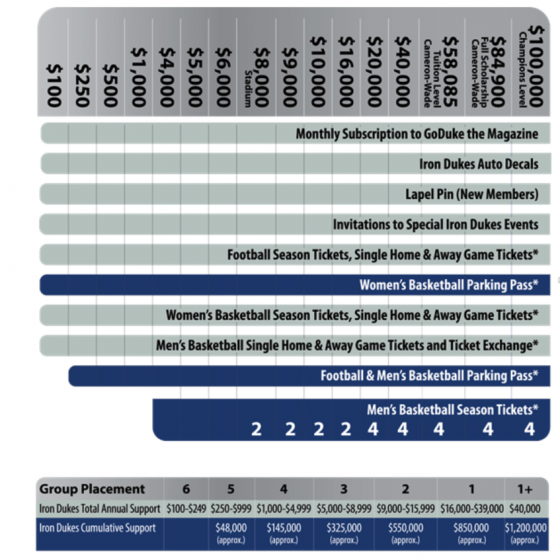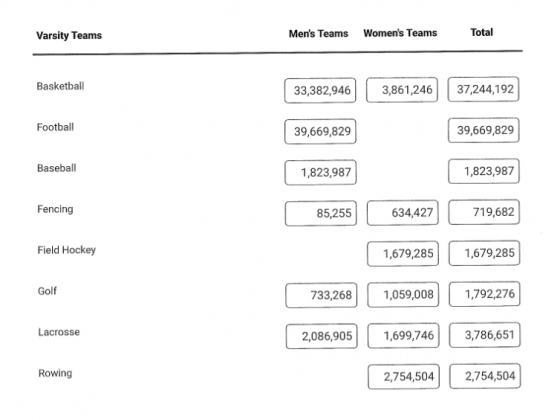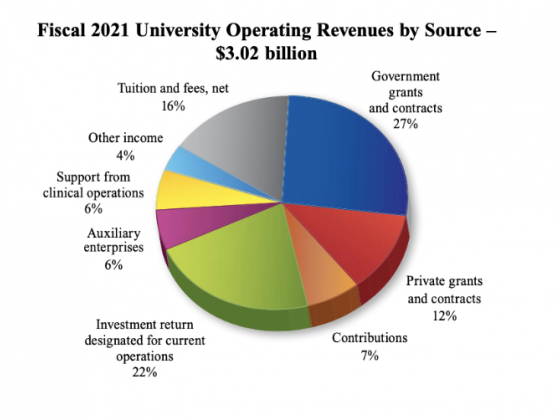By Alexander McMullen, Koby Cohen, Eli Baker, Brandon Lee, Jonta Robertson
The monetization of college athletics and its immense revenue generation has led to universities devoting hundreds of millions of dollars to preserving varsity athletics at their institutions. This development has seen rapid change since the beginning of the twenty-first century, and more money than ever has been pushed into sports since the creation of new name, image, and likeness policies. While the growth of intercollegiate athletics continues to take shape, looking into the financial infrastructure of universities, conferences, and the NCAA can illuminate key social and cultural trends in the sports industry.
Intercollegiate athletics relies on the devoted commitment of alumni and trusted board members who demonstrate their loyalty to their universities on a perennial basis. This loyalty is provided through alumni funds that help subsidize large portions of the athletic fund used by student-athletes and Duke Athletics. Schools across the country at any program have their own variation of an athletic fund, and at Duke this is known as the Iron Duke Fund. When an alumni or donor gives to the Iron Dukes Annual Fund, they contribute financial resources to help Duke Athletics fulfill areas or pressing needs (Iron Duke Annual Fund 2022). One of the largest contributions of this fund is the allocation of donated money to the scholarship fund used for student-athletes. There is no limit to the Iron Duke Fund that one individual cannot donate, but the minimum donation must start at $100. While providing opportunities to student-athletes through scholarship funds is the chief principle of the fund, there are intrinsic benefits that are scheduled to Iron Duke supporters at given tier levels. These incentives include, but are not limited to, Iron Duke specific events all the way to sporting event game day parking passes (Iron Duke Annual Fund 2022). The continued annual support to these types of funds is the backbone of the on-going success of Duke’s athletic programs and are critical at all institutions operating in the intercollegiate space.
The cost of athletic scholarship varies across institutions, but when looking at the finances of Duke, a single athletic scholarship for the 2021-2022 academic year was$84,900. This price includes estimated academic totals at $20,000,000 in tuition and fees plus $6,900,000 in room, board, and cost of attendance (Iron Duke Annual Fund 2022). The breakdown of financial resources to student-athletes can be viewed through Duke Athletics’ public website with men’s athletic-related student aid being $12,281,649 and women’s athletic-related student aid being $11,584,803 in the 2020 year (EADA Disclosure 2020). Funds like the Iron Duke system are a major factor in financing these resources to the student-athletes of Duke that may not be able to meet the extreme financial demands required to be a student at Duke University. These financial contributions are also extended to funding various academic programs committed to upholding the academic pursuits of Duke student-athletes through mentorship, tutoring, and service. Besides these immediate numbers, much of the data that investigates the finances of Duke Athletics is hidden. The outstanding financial contributions to the athletic programs are somewhat public information, but the detailed breakdown of every cent poured into the Iron Duke Fund will never be publicized. We have a general idea of who pays the $70,000,000 to uphold Duke Athletics and the incentives they receive doing so, but there are more compelling ideas surrounding Duke Athletics finances when diving into the discussion of scholarship money provided to men and women student-athletes. Looking into the scholarship breakdown of Duke student-athletes, there is a near $650,000 gap between men and women in athletic-related aid (EADA Disclosure 2020). This is explained through the number of student-athletes based on gender competing at Duke, but it opens the door to more discrepancies in financial distribution to men’s and women’s programs. It makes us wonder what other discrepancies in financial aid Duke provides to its men's teams that they do not for their women counterparts.
When first looking at the finances of Duke Athletics, there are some eye-catching numbers that must be addressed before going into the trends of male and female backing by the institution. The revenue generated by each program displays noteworthy data as Duke Football leads the way in revenue production with $39,6669,829 in the 2020 cycle. This is $6,000,000 more than the second highest revenue earner in the famed Duke Men’s Basketball program (EADA Disclosure 2020). Following the trends of similar institutions, the football program at Duke is the most important in a financial sense as it offers the most return on investment. This is surprising to some due to the lack of recent production and winning seasons from the program, nonetheless the television contracts provide a substantial portion to the finances of Duke Athletics. This is in turn why Duke has committed large portions of their fund to supporting their football student-athletes. While the men’s program does not incur as much revenue to Duke Athletics, it provides more intrinsic value through the growth of the Duke Athletics brand. The Duke Men’s Basketball Program is easily one of the most identifiable programs in all of sports, which drives in viewership from across the world.
Looking into the case of Duke Football and its revenue creates a compelling idea that the inputs provided to a program does not necessarily represent the outputs. While the operating expenses and revenue generated by the program is Duke Athletics’ largest financial commitment, it begs the question of reallocating money to other programs who are more successful, but less popular. The discussion around the finances of Duke Athletics evolves when looking into the influential effects the COVID-19 pandemic had on the institution, and this address of revenue only opens the door to looking into the major discrepancies in financial commitment to the men’s and women’s programs at a top university like Duke.
The pandemic affected nearly every facet of campus life that included a high number of student attendance. Social-distancing and risk-averse consumer sentiment shifted the appeal of on-campus activities, and in turn, lowered the resulting revenue. Specifically focusing on Auxiliary enterprise revenues, which “include athletics, residence halls, dining services, parking, ..., retail stores..., revenues from athletic ticket sales, media rights, licensing, and other contracts,” saw a “24% decline in revenue compared to fiscal 2020” (Duke University 2021). Despite only being 6 percent of all Duke’s operating revenues, these Auxiliary enterprise revenues equate to $186 million of the $3.02 billion of operating revenues.Despite the percentages appearing minimal, the 2020 year alone saw a revenue decrease of $44.7 million solely with respect to auxiliary enterprise revenues.
According to the Chief Financial Officer for Duke Athletics before the 2021 year, “athletics currently projects a total loss of revenue of around $36 million due to the pandemic” (Griffin2021). The main causes according to Duke Athletics include: the cancellation of last year’s men’s basketball tournament, reduced capacity for football and basketball games, and a hit to philanthropic donations. These collectively will reduce revenues by $32.5 million, assuming we use the “best-case financial impact of the pandemic” given from the Athletics department itself (Griffin2021). This lowered revenue prediction is considering what Heather Ryan noticed, “that 26 of Duke’s 27 teams will play (this 2021 Spring Semester), after the NCAA moved fall championships except for football to the spring” (Griffin2021). Measures have been taken to mitigate this revenue loss. Mitch Moser said that “reducing financial aid expenses, cutting non-compensation operating budget and salaries for employees making more than $50,000 a year, and starting a new fundraising initiative that has brought in more than $1 million” would help compensate for this loss (Griffin2021). Despite the pandemic impacting all people, employees saw a drop in compensation merely due to the Athletics program’s falling short. Despite only being 6% of the operating revenues, the drop in revenue was what was used to justify lowered employee compensation. Changes in other sources of revenue with larger proportions in the operating revenue diagram were not used to justify the pay reductions. It was only when athletics revenue saw a drop that Duke decided there needed to be restructuring to their compensation packages for employees wholly unrelated to athletics. Like most businesses, in the face of lowered revenues came the incentive to cut costs to preserve their profit margins.
All these reductions in revenue are in the face of the efforts to contain COVID-19-19 on Duke’s campus. Across the time between July 12th, 2020, and January 23rd, 2021, 117 student-athletes or staff tested positive for COVID-19-19. These positive cases occurred throughout various teams and frequently had cases clustered together. When looking into the finances of Duke Athletics, it is undeniable that the pandemic played a major role in the operation of the department in 2020 and beyond. How and why the department allocates money in certain ways can be described partly by the difficulties posed by the pandemic, but we feel this does not tell the complete picture.
The gender disparity in athletic funding and financing should come as no surprise. Virtually all dimensions of profit generation in sports favor and advantage men over women. Quantitative and narrative evidence brought to light in recent years have forced collegiate and professional institutions to make pledges for a better future. Specifically, Duke University has openly touted its commitment to equity in sports across news and social media channels. As early as 2003, the Athletics Department pledged to raise the “rates of aid and participation for women” in line with female enrollment (Duke Magazine, Jan-Feb 2003). However, the still-present, deep inequities in the Duke Athletics budget challenge the feasibility of Duke’s aspirations without broad, systematic change.
Duke leads its conference counterparts on several metrics. Excluding football and men’s basketball, University spending in 2020 for female sports exceeded men’s by over $6m (EADA Disclosure 2020). Furthermore, a significant share of profit from football and men’s basketball goes toward the total $70 million paid out by Duke Athletics. In defense of Duke, it has arguably led its nationwide counterparts on the path towards gender equity in athletic funding. However, the focus of this investigation is why we have not yet crossed the finish line, and what is holding us back.
The University’s reliance on external sources of funding challenge serious budget restructuring. The primary revenue streams totaling $70 million (boosters, NCAA, ACC, sponsorships) are often conditional, relying upon countless variables ranging from a successful season to the whims of a wealthy donor. Accomplishing equity in areas such as head coaching salaries and recruiting expenses would require acknowledgement of fault, a historical weakness of athletic authorities. Whether these additional funds are diverted from the few profitable teams or private sources requires negotiation between Duke and all other parties in its (far-too complex) ‘sports-industrial complex.’ Few parties are granted access to the inner-workings of the athletic profit-generating machine, but present realities demand greater transparency moving forward regarding sports financing.
The revenue breakdown of the most recent Duke Athletic financial data reveals only three teams earn a considerable profit. Men’s football, basketball, and women’s soccer aid the daily operations of almost all other teams at Duke. However, a few notable exceptions -women’s golf, women’s swimming & diving, women’s track & cross country -earn marginal profits which are self-sustaining, but do not contribute much otherwise to the total $70 million. Specific analysis of the financial and operational factors contributing to these teams’ sustainability could yield incredible benefit to both Duke and its student-athletes. If individual teams are given greater latitude to rectify their balance sheets, incentives from the University could reap numerous benefits for team members and staff. Professors and students alike could actively contribute to creative solutions enabling deliverance of many University promises.
The priorities of Duke University and the Duke Athletics Department are abundantly clear in examining finances from a holistic standpoint as well as the impact of the COVID-19 pandemic on revenue. In analyzing recruiting expenses, there is a significant disparity of about 3:1 for men's and women’s teams (EADA Disclosure 2020). Recruiting represents one of the most transparent signs of priorities of the department, as it demonstrates Duke’s willingness to spend to attract talent based on gender. This gap will likely further increase with policy changes to NIL. Diving deeper, the disparity between men’s and women’s total expenses (including football and men’s basketball; not including expenses not allocated to gender/sport) of greater than 2:1 demonstrates a notable difference in priority related specifically to the bottom line of the department. With basketball and football generating a combined $73,052,775 in revenue (66.5% of total department revenue), the Duke Athletic Department puts most of its inputs into sports that generate the greatest amount of revenue.
As demonstrated in the analysis of the impact of COVID-19 on Duke athletic finances, the main factors of financial trouble that impacted Duke Athletics included the cancellation of the NCAA tournament, decreased ticket sales for men's basketball and football, and decreased philanthropic donations (Griffin 2021). Men's basketball is the fuel for the Duke Athletics Department financially. However, since 2000, Duke University has won ACC Championship titles in Men’s Basketball, Women’s Basketball, Men’s Cross Country, Women’s Cross Country, Men’s Fencing, Men’s Golf, Women’s Golf, Men’s Lacrosse, Women’s Lacrosse, Men’s Soccer, Men’s Tennis, Women’s Tennis, and Volleyball. Thus, if Duke teams are successful in numerous different sports, why is the majority of expenses spent on men’s basketball and men’s football (a team that has not won an ACC championship game since 1989 (shared with UVA). The motivation related to budgeting in the Duke Athletics Department is strictly profit-based. Their commitment to teams is not based on the merit of team success. Rather, it is based on the financial output generated by each team. This is problematic because it creates a cycle at Duke of determining financial inputs based on previous output, leading to significant discrepancies in funding. This disparity reinforces gender inequity and puts teams with little funding at a disadvantage with respect to competitive balance.
Works Cited
Athletics Department, Duke. “EADA Disclosure.” 2020 EADA Disclosure, 2020, goduke.com/documents/2020/12/30/2020_data.pdf.
Athletics Department, Duke. “Iron Duke Annual Fund.” Duke University, 2022, goduke.com/sports/2020/6/5/178280.aspx.
Griffin, Matthew. “Athletics Projects $36M in Lost Revenue Due to Covid-19, Details Positive Tests among Students and Staff.” The Chronicle, 23 Jan. 2021, www.dukechronicle.com/article/2021/01/duke-university-athletics-lost-re….
Magazine, Duke. “Jan -Feb 2003.” Duke, 2003, alumni.duke.edu/magazine/issue/jan-feb-2003.
University, Duke. Financial Statements 2020/2021. 2021, resources.finance.duke.edu/resources/docs/financial_reports2020-21.pdf.


